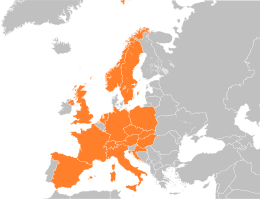European Solar Telescope
The European Solar Telescope (EST) is a pan-European project to build a next-generation 4-metre class solar telescope, to be located in the Canary Islands, Spain. It will use state-of-the-art instruments with high spatial and temporal resolution that can efficiently produce two-dimensional spectral information in order to study the Sun's magnetic coupling between its deep photosphere and upper chromosphere. This will require diagnostics of the thermal, dynamic and magnetic properties of the plasma over many scale heights, by using multiple wavelength imaging, spectroscopy and spectropolarimetry.
 | |
| Alternative names | EST |
|---|---|
| Location(s) | Canary Islands, Spain |
| Built | 2021 |
| Telescope style | optical telescope solar telescope |
| Diameter | 407 cm (13 ft 4 in) |
| Secondary diameter | 80 cm (2 ft 7 in) |
| Angular resolution | 0.03 arcsecond |
| Collecting area | 13.0 m2 (140 sq ft) |
| Mounting | altazimuth mount |
| Enclosure | dome |
| Website | www |
The EST design will strongly emphasise the use of a large number of visible and near-infrared instruments simultaneously, thereby improving photon efficiency and diagnostic capabilities relative to other existing or proposed ground-based or space-borne solar telescopes. In May 2011 EST was at the end of its conceptual design study.
The EST is being developed by the European Association for Solar Telescopes (EAST), which was set up to ensure the continuation of solar physics within the European community. Its main goal is to develop, construct and operate the EST.[1] The European Solar Telescope is often regarded as the counterpart of the American Daniel K. Inouye Solar Telescope which is currently being constructed.
Conceptual design study
The conceptual design study[2] conducted by research institutions and industrial companies was finalized in May 2011.[3] The study took 3 years, cost €7 million and was co-financed by the European Commission under the EU’s Seventh Framework Programme for Research (FP7).[4] The study estimates a €150 million to design and construct the EST and projects about €6.5 million annually for its operation.
Partners

The European Association for Solar Telescopes (EAST) is a consortium of 7 research institutions and 29 industrial partners from 15 European countries, that exists with the aim, among others, of undertaking the development of EST, to keep Europe in the frontier of Solar Physics in the world. As well as EAST intends to develop, construct and operate a next-generation large aperture European Solar Telescope (EST) in the Canaries, Spain.
| Institute | Location | ||
|---|---|---|---|
| IGAM | Institutsbereich Geophysik, Astrophysik und Meteorologie | Graz | |
| HVO | Hvar Observatory | Hvar | |
| AIASCR | Astronomical Institute AS CR | Ondrejov | |
| THEMIS | THEMIS S.L.,[note 1] INSU-CNRS, CNR | Paris | |
| KIS | Kiepenheuer-Institut für Sonnenphysik | Freiburg | |
| UniDeb | Heliophysical Observatory Debrecen | Debrecen | |
| INAF | Istituto Nazionale di Astrofisica | Rome | |
| UU | Ultrecht University, Sterrekundig Instituut | Utrecht | |
| ITA | Institute for Theoretical Astrophysics | Oslo | |
| IA UWr | Astronomical Institute of the Wroclaw University | Wroclaw | |
| AISAS | Astronomical Institute of the Slovak, Academy of Sciencees | Tatranská Lomnica | |
| IAC | Instituto de Astrofísica de Canarias | La Laguna | |
| SU | Institute for Solar Physics | Stockholm | |
| IRSOL | Istituto Ricerche Solari | Locarno | |
| UCL-MSSL | University College London - MSSL | London | |
See also
References
- The European Solar Telescope
- "Conceptual Design Study - Final Report" (PDF). www.themis.iac.es. Archived from the original (PDF) on 23 May 2014. Retrieved 23 May 2014.
- "Partners Institutions". www.est-east.eu. Archived from the original on 20 October 2013. Retrieved 23 May 2014.
- "SUCCESS STORIES - How much money has the EU invested in this?". ec.europa.eu. Retrieved 23 May 2014.
Notes
- The THEMIS Limited Company has been created in 2000 as a Spanish rights company and a joint operation between Spain, Italy, and France and owned by the French CNRS "Centre National de la Recherche Scientifique" (80%) and the Italian CNR "Consiglio Nazionale delle Ricerche" (20%).